Matson
Lines S.S. Mariposa & SS Homeric
Please Note: Firefox & Google Chrome other search engines may not suitable
Please use Internet Explorer or old Google for this page to load perfectly!

Click
the logo above to reach the ssMaritime FrontPage for News Updates
With Reuben Goossens
Maritime
Historian, Cruise‘n’Ship Reviewer & Author
Please Note: All ssMaritime and other related maritime/cruise sites are 100%
non-commercial and privately owned. Be assured that I am NOT associated with
any shipping or cruise companies or any travel/cruise agencies or any other
organisations! Although the author has been in the passenger shipping industry
since 1960, although is now retired but having written on well over 700 Classic Liners, humble Migrant Liners and
Cargo-Passengers Ships I trust these will continue to provide classic
ship enthusiasts the information they are seeking, but above all a great deal
of pleasure!
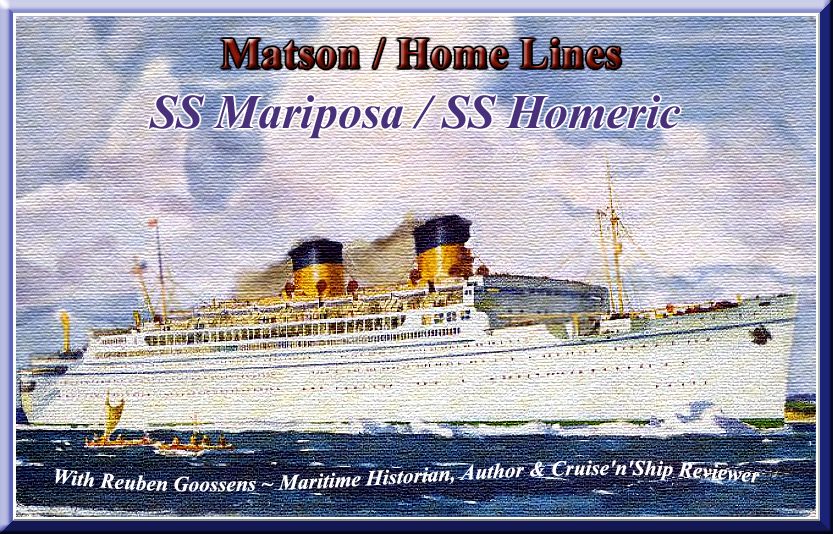
A
generic Matson Lines postcard released prior the “White Fleet”
commenced sailing
Original
postcard from the author’s private collection
Brief Introduction:
After the
red-hulled SS Malolo built in 1927, the luxury American
ocean liner, SS Mariposa the first of three ships in the Matson Lines to
be known as the “White Fleet.”
1 … Mariposa (2) was launched July 18
1931. In 1954 she was sold, and her details are on this page below.
2
… Monterey
was also launched in 1931, renamed Matsonia in May 1957, renamed Lurline in
1963. In May 1970, she was sold and became the successful Chandris passenger
liner, the RHMS Britanis.
3
… Lurline was launched on July 18 1932, and was the only ship to retain
her original name until being sold in September 1963 to become the Chandris
Liner the RHMS Ellinis.
Although
all these ships had further careers with other companies after Matson Lines,
sadly the SS Mariposa did have the shortest life at sea of them all, whilst the
second ship of the trio, the SS Monterey then named the Britanis ended her
career in 2000, and the third ship, the SS Lurline named Ellinis ended her days
in 1987.
SS Mariposa (1):
The first Mariposa was built in 1883 William
Cramp & Sons Shipbuilding Company in Philadelphia the “Oceanic
Steamship Company,” which had been founded in 1881 by John D. Spreckels
& Brothers to provide a passenger and cargo service between San Francisco and Honolulu
Hawaii.
Later the service was extended as far as New Zealand
and Australia.
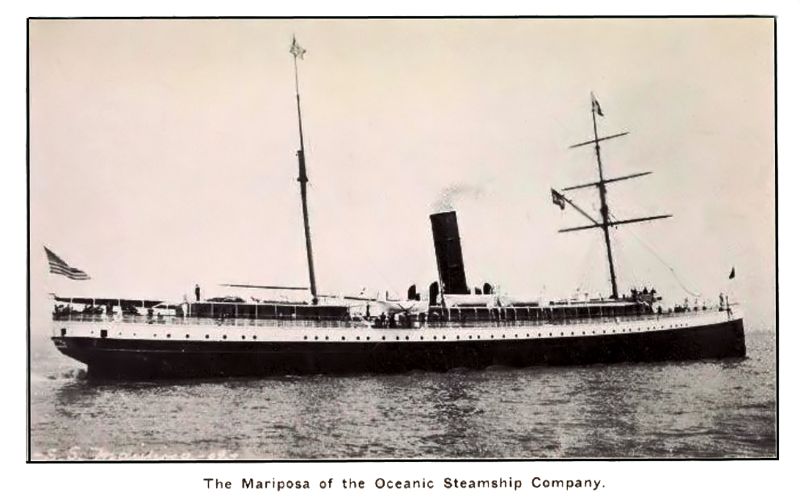
A
fine postcard of this first SS Mariposa
Postcard
from the author’s collection
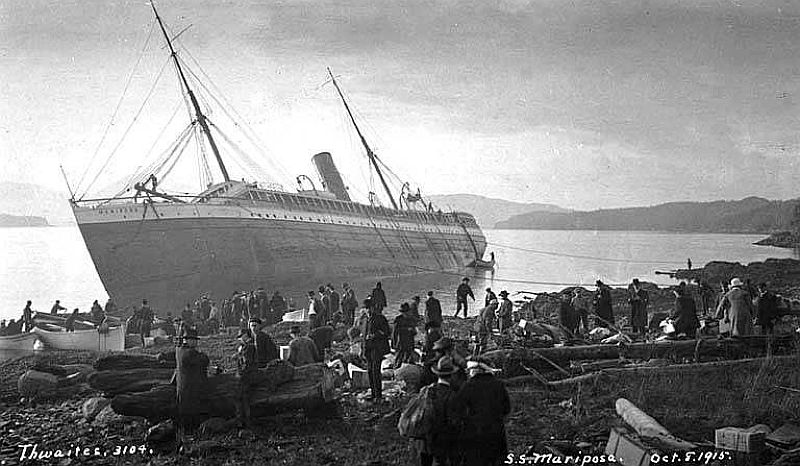
Here
we see the passengers ashore and the ship floundering
Photograph
by “Thaites,” – but part of the author’s private
collection
She was sold in 1912
to the “Alaska Steamship Company,” retaining her original name.
However, just five years later on December 18, 1917, she hit a reef off the
coast of British Columbia
and took on water and soon capsized, all passengers and crew were able to
abandon ship. In 1926 the “Oceanic Steamship Company” was bought
out by Matson Line and it became a full subsidiary.
SS Mariposa
(2):
Withy the SS Malolo having been
placed in operation in 1927 and proving to be very successful, Matson Lines
decided to build a trio an even more luxurious liners, the first being the
18,000 tonner, SS Mariposa to be built by the famed Bethlehem Ship Building
Corporation, Quincy, Massachusetts. She was launched on July 18 1931 and was
completed on December 14. Having made her deep-sea trial successfully she
headed for the West Coast of America to be stored up and fully manned.
Obviously the publicity machine was in full operation to get booking flowing
and it proved to be successful!
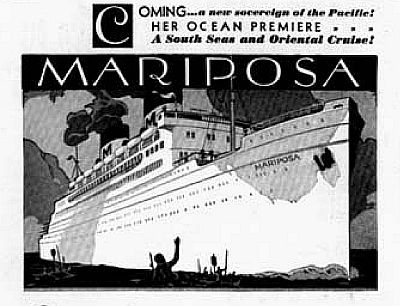
Part
of an advertisement announcing the arrival of the Luxurious SS Mariposa
From
the author’s private collection
The magnificent SS
Mariposa (2) departed San Francisco for her maiden voyage
on February 2, 1932 bound for Honolulu, Auckland, Wellington and Sydney
arriving there on 21 February and departed the next day. She proved to be very
popular, as did her sister that followed her soon after, the SS Monterey.
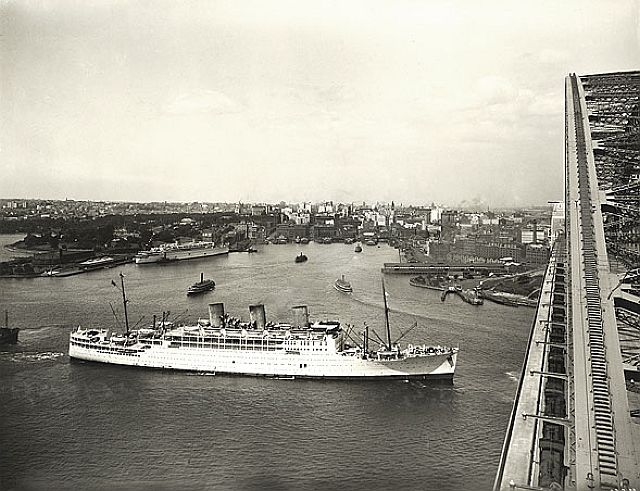
Here
is a rare photograph with a view of Circular Quay in Sydney
with the SS Mariposa is seen
berthed.
The RMS Strathnaver is seen just arriving. Mariposa was on her Maiden voyage to
Australia
and this photograph was taken on February 22, 1932
Photographer
unknown – Please see photo notes at the bottom of the page!
The Mariposa and her
sisters soon became famed for being some of the most handsome and certainly the
fastest ships on the Pacific. She had?
long sleek lines with her all white livery and a low slung
superstructure and her two beautifully placed funnels combined with her slim
tall fore and main masts. And as Mariposa had crossed the Pacific during her
maiden voyage at an average spewed of 22 knots she proved that she and her two
sisters were indeed a force to recon with! Her sister SS Monterey (1) followed
her into service on May 1932.
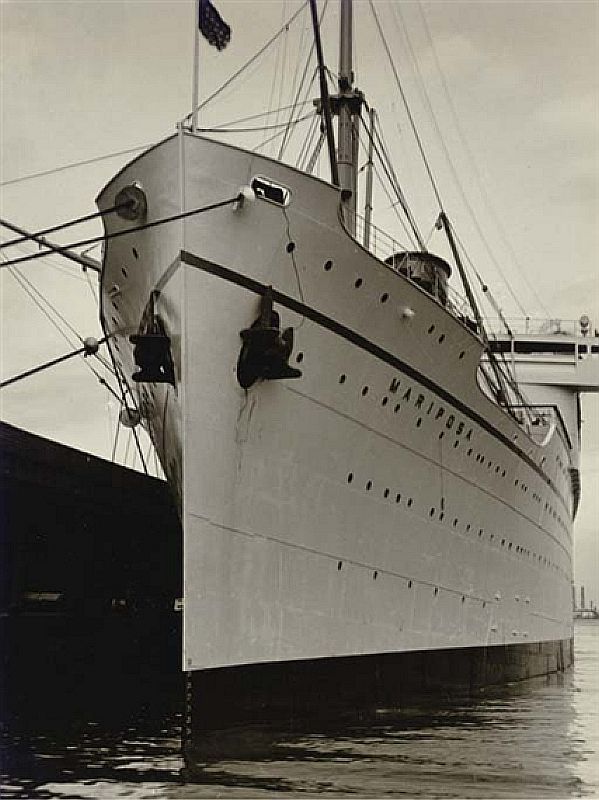
A
fine view of he bow
Photographer
unknown – Please see photo notes at the bottom of the page!
Although many say
that the Mariposa was very much designed in similar vain to the SS Malolo, they
are in fact quite different! The most obvious is that Malolo’s lifeboats
are slung low on boat deck, whilst on the “White Fleet” they are
raise up high!? The length was far
greater and her superstructure was a superior one and more integrated with her
hull design in addition it was aerodynamically superior. Another unusual
feature was that the aft funnel was slightly shorter than the forward one, thus
giving the ship a more stylish overall profile. This very same idea was adopted
by many great companies throughout the world in the future, until a single
funnel became more popular.
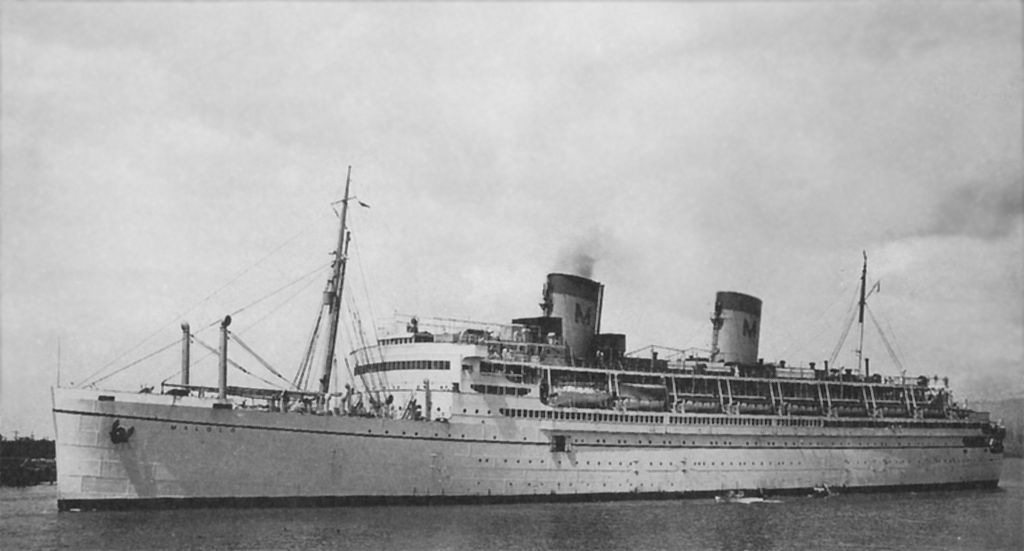
SS Malolo seen in Sydney
November 26, 1929, after having been painted
all
white from her previous all red hull
Provided
by Dr. K. G. Jamison Jnr.
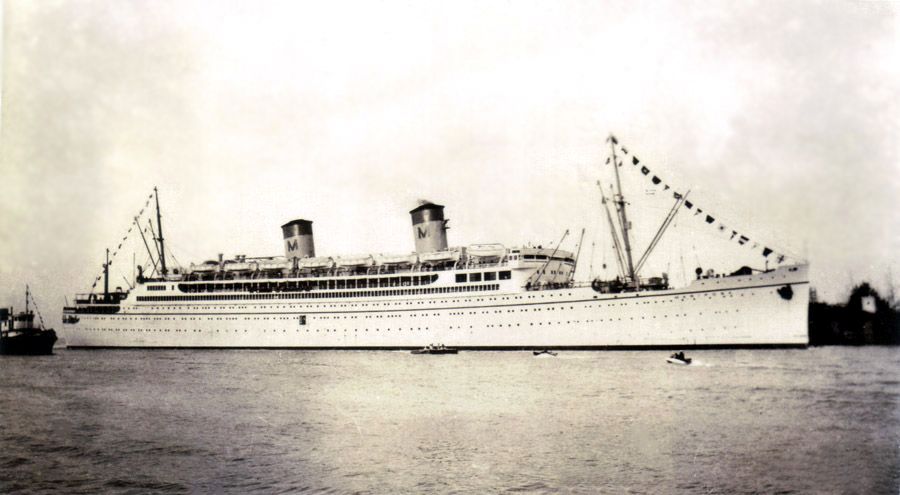
An
elegant looking SS Mariposa
Photograph
by John Smoot, from the Rich Turnwald collection
Interiors:
Mariposa’s interiors had that
traditional glamorous Matson feel, with spacious public venues and sumptuous
accommodations. In those early days of ocean travel was the new idea of
air-conditioning, and the Mariposa introduced it into their spectacular First
Class Dining Room, which made dinning in the humid climates of the South
Pacific and heat in Australia
so much more comfortable!
The Images below represent the SS Mariposa as
well as other ships in the “White Fleet.” Sadly not a great number
of pre-war images are available, and these are the only ones that seem to have
survived, but they provide a marvellous idea of the luxury provided on these
ships!
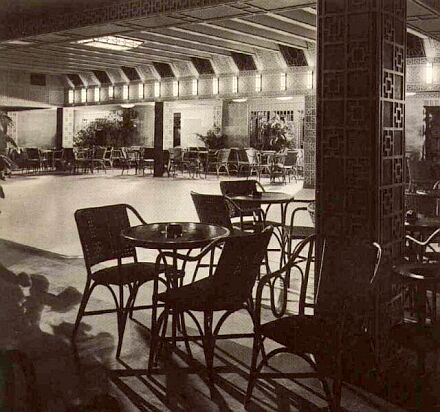
Verandah-Caf?
All
images are from the author’s private collection

Writing-Room
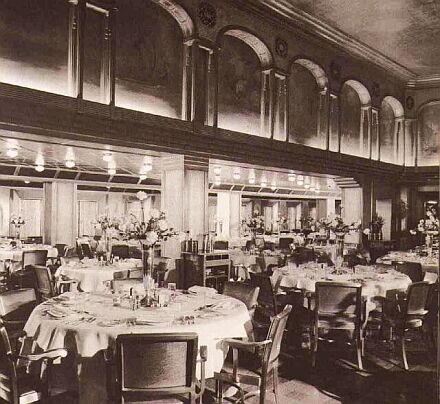
The
Grand Dinning Room was two decks high and had a band stand above
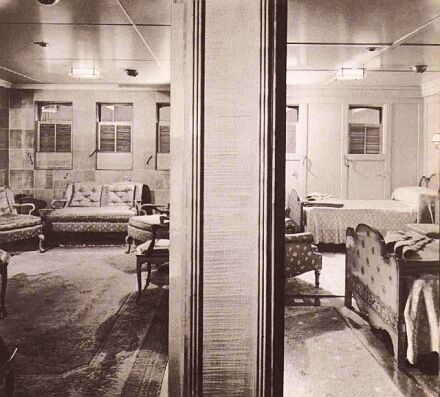
One
of the six deluxe Suites with a lounge and a separate bedroom
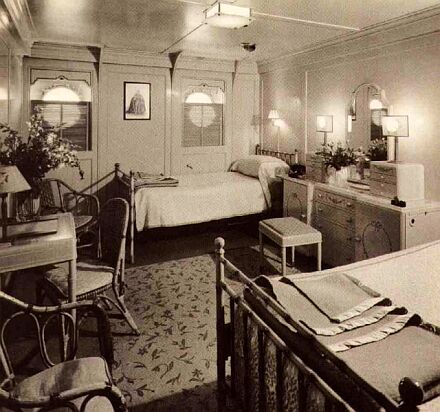
A
spacious twin bedded Stateroom
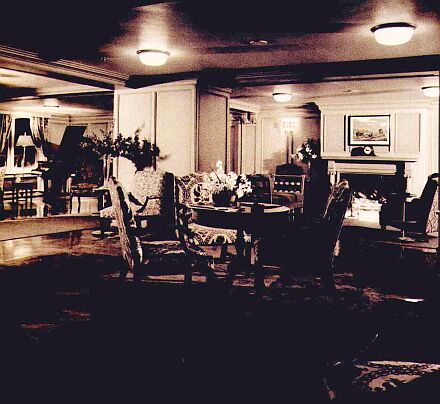
The
Cabin Class Lounge was elegant and led into the Ball Room
Down Under the SS Mariposa became
a greatly admired ship, being the first of the trio and she was extremely
popular, thus many Australian’s and New Zealander’s would sail on
her, either as a round voyage, come cruise, or even as a short Trans Tasman
voyage. The short Tasman voyages was an opportunity for some to experience that
special American luxury, a style that was beyond compare in those days, and the
ship was simply one of the finest, even Cabin Class offered excellent style and
service! And when they came home, hey were able to say, “I sailed on the
Luxury Speed Queen of the Pacific” and everyone would know that it was
the Matson liner Mariposa!
However, her speed record was overtaken in
1938, and no not by a British ship, or another American ship, but believe it or
not, a brand new super luxury liner built especially for the Union Steam Ship
Company of New Zealand, the TSS Awatea. The Mariposa had departed Auckland for Sydney
and the Awatea departed about four hours later, bust she passed the Mariposa in
the Tasman on June 13, 1938, as she has an average speed of 23.1 knots, making
her the “Greyhound” of the Tasman as well as the Pacific! One thing
the Tasman Sea is very famous for and that is some of the wildest seas anywhere
and Mariposa had to fight her way through a good number of these over the
years, but, more often than not the Tasman will be as smooth as silk, for the
author has sailed the Tasman around 24 times and only struck it bad twice.
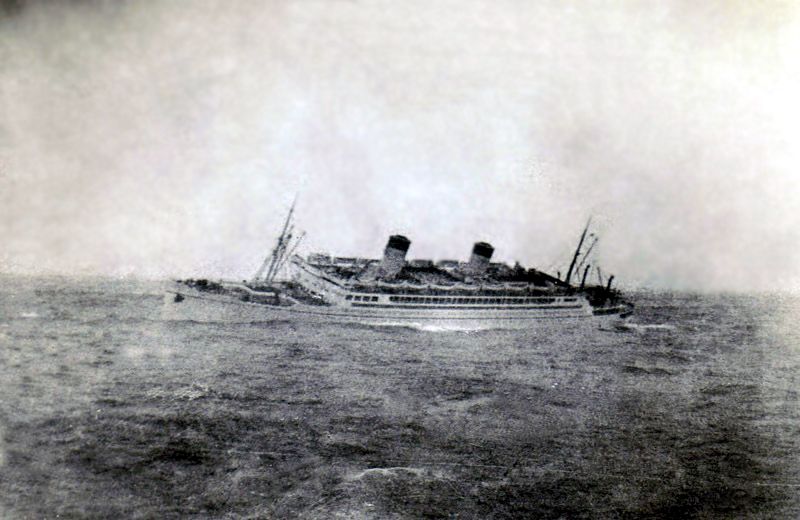
This
is what the Tasman
Sea can be like
From
the author’s private collection
Mariposa, like all Matson liners
were famous for extravagant Dining Rooms and the finest of meals and service in
both classes. But there was one feature that stood out until the final two
Matson ships, the Monterey
and Mariposa which were sold to the Pacific Far East Line in 1970, that saw the
end of Matson passenger fleet! But, what was that one feature that is still
treasured by past passengers and maritime collector’s throughout the
world, the “Matson Line Menus” for they are famed for their
excellent covers, that have water colours that highlight the Pacific and The
Ports of Call, as well as covers that a very special and unique! I will show
just two below.?
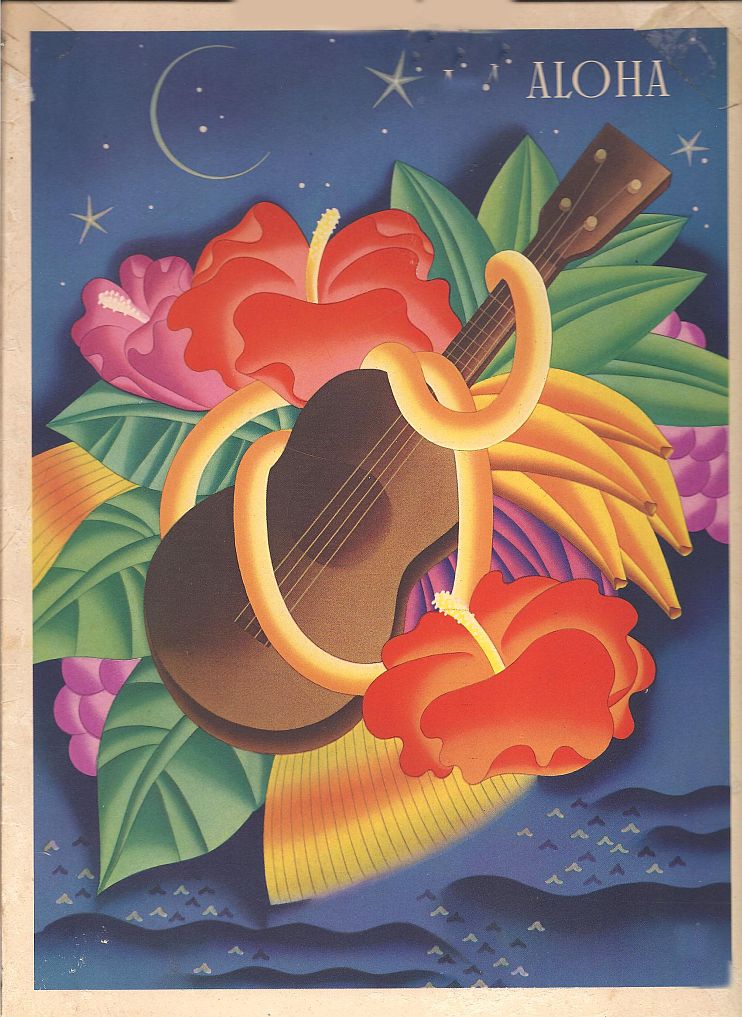
Above
and below: A series of Pacific inspired menus
covering a number of years
All
three menu covers have been provided by past passengers


Here
we see one of the unique covers with a touch of gold and velvet, this menu was
for a formal evening
These
days, menus are in plastic covers and are not dates as most are used over and
over again
Only
some are given to passengers who want them as a souvenir
World
War II – The Trooper:
Like most passenger ships around the world,
Mariposa’s career was cut short late in 1941 as she had been
requisitioned by the United States Government and she was to be converted for
the use as a troopship. She was laid up side by side with her sister the Monterey and after the attack on Pearl
Harbour
she received her refit and was soon ready for duties as a trooper for the next
five years. The poor Mariposa as a ship suffered badly during her service, but
she continued courageously.
Please note: I
have little to no information available regarding her active duties, thus if
anyone can assist with an outline of her service it would be greatly
appreciated!
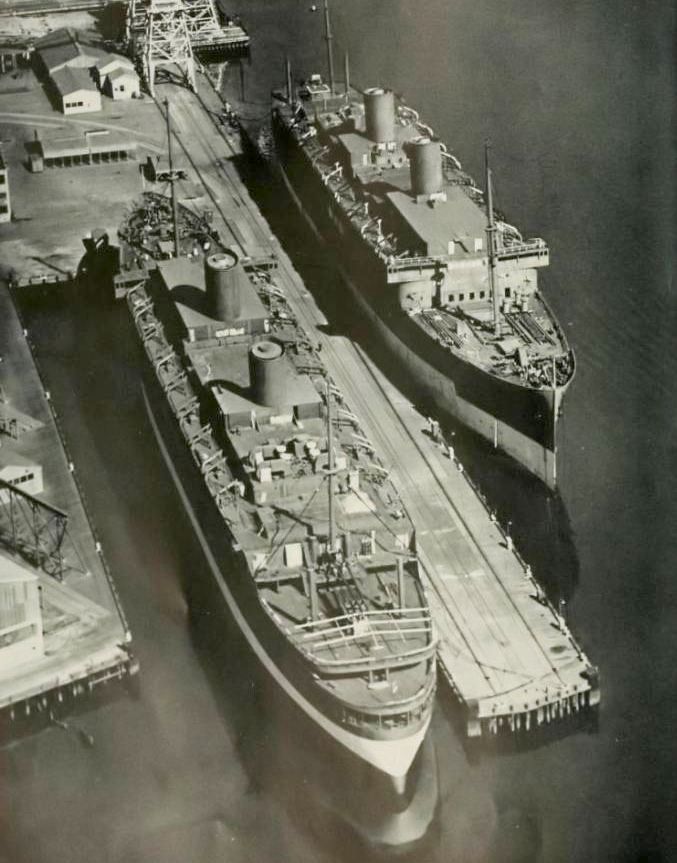
SS Mariposa (left) and Monterey
seen laid together awaiting conversion for war duties
Photographer
unknown – Please see photo notes at the bottom of the page!
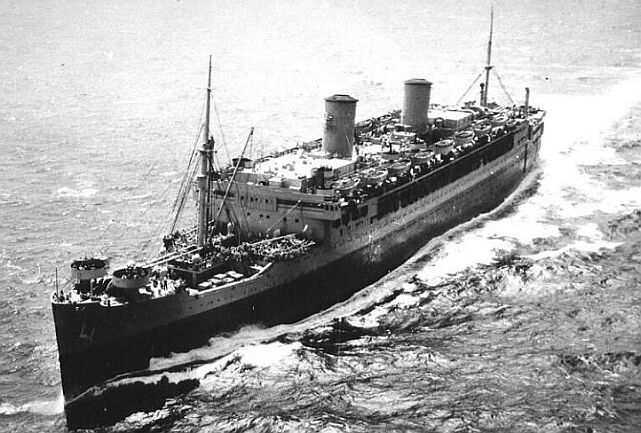
Mariposa
seen fitted with her guns and full of troops at sea
Photographer
unknown – Please see photo notes at the bottom of the page!
Once glamorous liner
SS Mariposa was returned to her owners in 1946, she looked sad and very tired
indeed, thus Matson sent her to Alameda
California
where she was to be refitted and restored to her former glory. However, upon
inspection the directors of Matson decided that the cost of refitting her would
be far too great, considering her extreme poor condition and felt it would be
better to retain her in lay up condition until a latter date. This turned out
to be a grand total of six years, until 1953 when she was placed on the market.
Mariposa’s Specifications:
Builders:????????????????????????????? Bethlehem Ship
Building Corporation, Quincy,
Massachusetts.
Yard:?????????????????????????????????? 1440.
Launched;???????????????????????????? July 18, 1931.
Tonnage:????????????????????????????? 18,017 GRT (Gross
Registered Tonnage) – 18,152 GRT in 1941 as a trooper.
Length:??????????????????????????????? 192.6m / 632ft.
Beam:????????????????????????????????? 24m / 79ft.
Draught:?????????????????????????????? 8.6m / 28ft.
Engines:?????????????????????????????? 6 steam DR Geared
Turbines (28,000 SHP).
Screws:??????????????????????????????? Twin.
Service speed:?????????????????????? 22 knots.
Passengers:????????????????????????? 475 First Class.
?????????????????????????????????????????? 229
Cabin Class.
Crew:?????????????????????????????????? 350.
Livery:???????????????????????????????? White
hull and superstructure, yellow & blue funnels & green boot topping.
SS
Homeric (2):
A sad looking SS Mariposa was
sold in 1953 to the Italian Home Lines of Genoa, which was registered as Home
Shipping Co. S.A., Panama.
Previously Home Lines had already purchased the SS Malolo and as she was
proving to be successful after an extensive refit, the company was looking for
a slightly larger ship and obviously another Matson liner was the perfect
option, especially as she was an empty canvas as she had almost been stripped
for the war effort! Before she could be moved her engines were completely
overhauled by Todd’s Shipyard at Alameda and then operated her sea
trails successfully she was renamed Homeric and she sailed still in a bare
state for Trieste,
Italy
in 1954.
In Trieste
she entered the famed Monfalcone Shipyard where she would be fully refitted
into a modern luxury liner, come cruise ship that would be in due course,
mostly used for the American market. Upon completion her external look was very
pleasing indeed, for now she had a very pleasing raked bow, and her
superstructure was more enclosed, where there were large windows, in the
forward section of Promenade Deck, there were now cabins, some with larger
square windows. One deck down amidships, the ex six Lanai Suites (3 each side)
had three floor to ceiling windows each, just like her two slightly newer
Matson sisters would have after their refits. Other changes were that her aft
derricks and hold, as well as her funnel caps were removed. With the hold and
masts gone an new spacious Lido Deck was installed complete with a swimming
pool. However, she even retained her old livery, except that her funnel was nor
a slightly brighter yellow and blue top, with a blue circle logo containing a
gold crown. But overall she still looked very much a Matson ship
as although there were differences, but her overall look had not changed.
During her deep-sea trials the Homeric reached a remarkable 23.5 knots, but it
was decided that she would sail at an average speed of 20 knots.
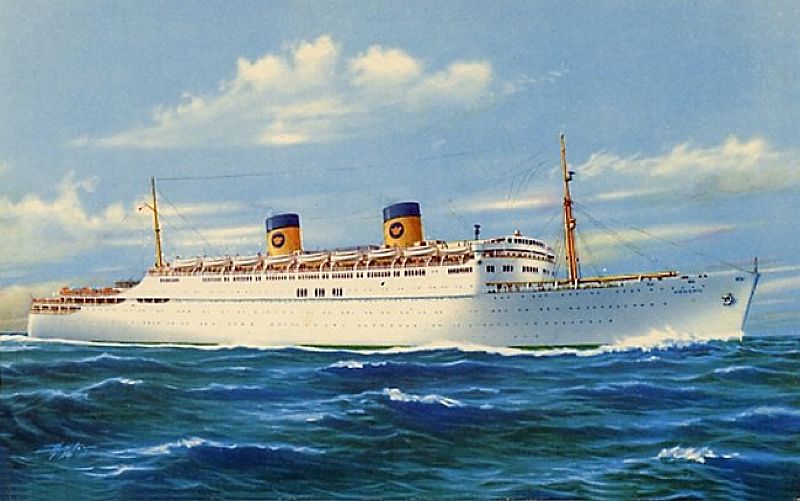
Popular
SS Homeric postcard released by Home Lines
From
the author’s private collection
Interiors:
First Class public Rooms were on Promenade
deck, with the pool aft one deck lower. Tourist Class venues were aft on Main
deck. The most attractive and greatly loved d?cor was very much based on
ancient Greek themes! Cabins were a simple delight on the Homeric as the were
light and beautifully installed, most featured beds folded into a recess, or
become a sofa during the day, making the room so much more spacious and useful
as a sitting room. All cabins on Upper, Main and half of those on A deck
had their own private facilities. As already mentioned there were six
magnificent two roomed deluxe suites on Upper deck, but also thirty superb
Tourist suites on Main deck. There was no doubt that both classes offered the
very best any ship could offer, and whenever she became a one class ship during
her winter cruises out of New York, and later as a full time American cruise
ship, she was one of the best around!
Trans Atlantic Liner:
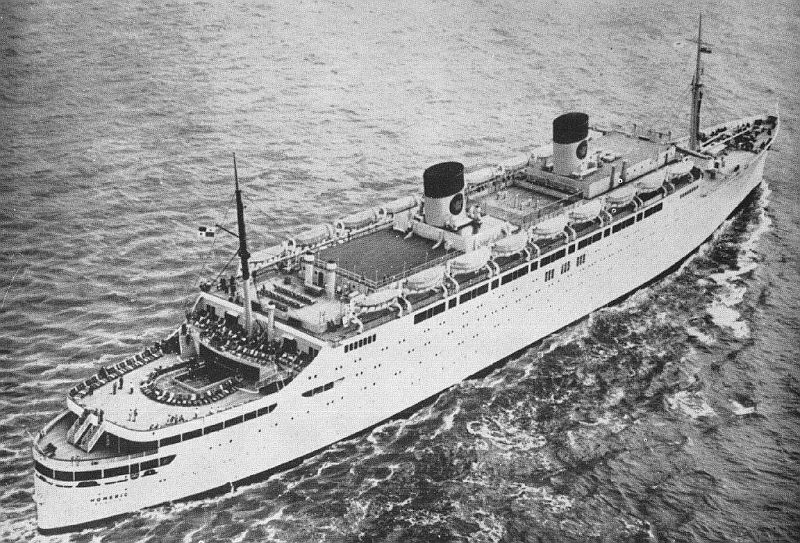
The
Homeric seen during an Trans Atlantic crossing
Home
Lines promotional Image - From the author’s private collection
She departed on her maiden voyage
from Venice
on January 24, 1955 bound for New York, and there is no doubt,
but she became one of the most popular ships on the east coast crossing the
Atlantic to England
(from May 1955) and Italy.
In 1957 she made her first voyage from Le Havre to Montreal, and occasionally Cuxhaven to Montreal.
Thus her Atlantic career was quite varied! However, from the very beginning of
her career, she would operate the Atlantic services most of the year, however
during the winter months she would operate cruises to the Caribbean cruises out
of New York
and her passenger complement was reduced to just 700.
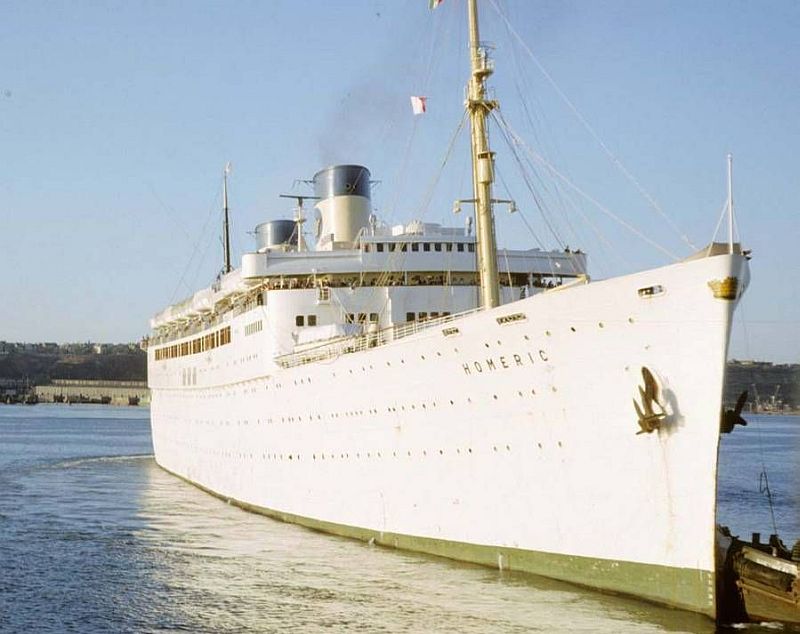
An
excellent photograph of the Homeric in New York
Photograph
by Vic Scrivens, from the Rich Turnwald collection
Homeric, the Cruise Ship:

The
SS Homeric at her New York
berth during the winter of 1969 before departing on a cruise to the Caribbean
Photographer
unknown – Please see photo notes at the bottom of the page!
Home Lines already having had considerable
experience with their winter cruise operations, which had proved to be highly
successful, and they decided it was time to redeploy the SS Homeric to the
United States and have her cruising there on a full time basis, as
American’s had fallen in love with this elegant and luxury liner! She had
an extremely successful ten years sailing from various US
ports to the lush tropical Islands of the Caribbean and other near by
destinations. In fact she proved to be one of the most admired ships of her
time!
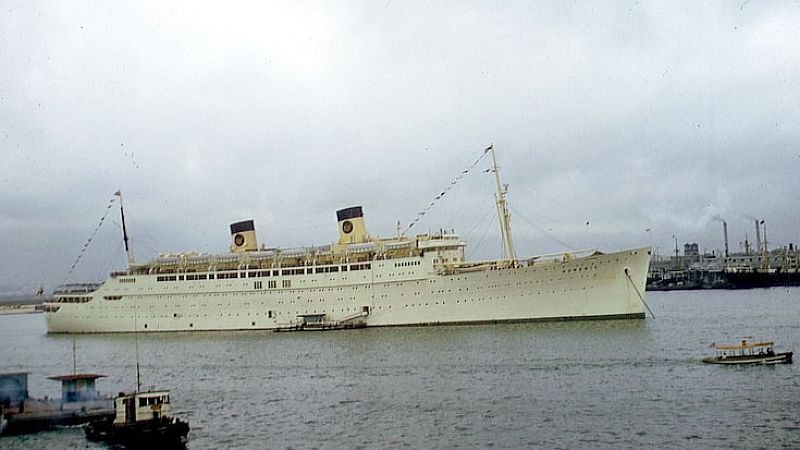
SS
Homeric is seen at anchor during a cruise
Photographer
unknown – Please see photo notes at the bottom of the page!
Homeric’s
Final Days:
As the super successful Homeric cruised on, it
would sadly end abruptly on July 1, 1973, whilst she was on a cruise and she
suffered a fire in her galley’s and dinning rooms. She was some 90
nautical miles west of Cape May and considering she was
unable to continue the cruise she for the nearest suitable port. The then
sailed to Genoa
under her own power for repairs, but as the damage was so extensive, Home Lines
decided not to go ahead and sell her to the breakers. She was purchased and
headed for Kaohsiung, where she arrived on January 29, 1974, at the Nan Feng
Steel Enterprises Co., and was laid up for a short time alongside the famous
Holland America liner, the SS Nieuw Amsterdam that was also awaiting her
demolition.
However, the Homeric’s steam turbines
were sold to Chandris Lines who where still operating her two sister ships, the
second ship of the trio, the SS Monterey then named the RHMS Britanis ended her
career in 2000, and the third ship, the SS Lurline named RHMS Ellinis ended her
days in 1987. Homeric’s turbines and other
fittings were fitted to the Britanis when she received a major refit in 1986,
thus the SS Mariposa lived on for another 26 years!
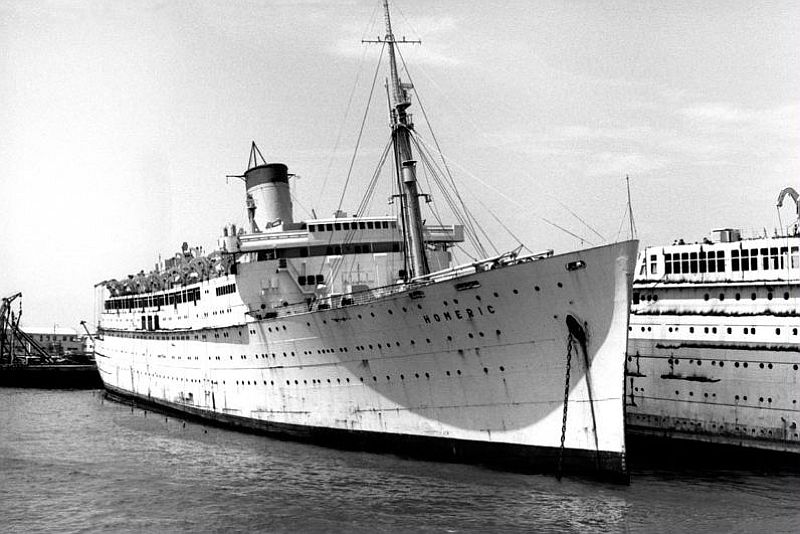
The
Homeric seen at Kaohsiung
Taiwan
in 1974, at the breakers yards – note her aft funnel is gone
Photograph by & ? Karsten Petersen Denmark
- http://global-mariner.com/index113ShipFerries.html
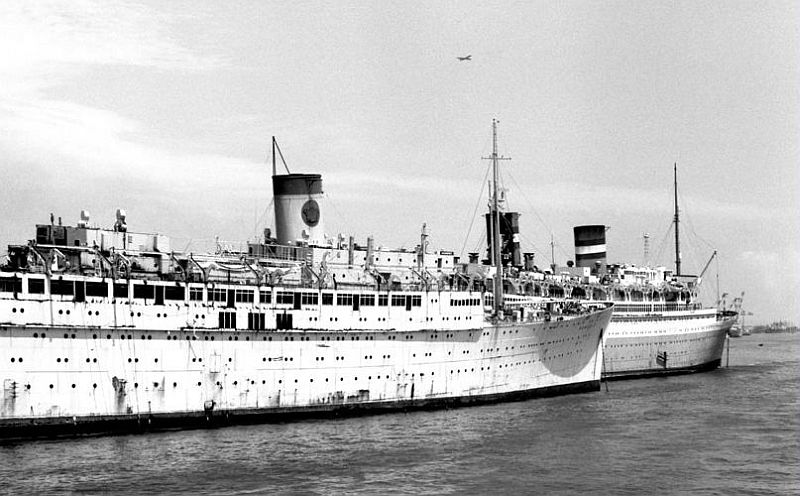
Another
photo of the Homeric in Taiwan,
waiting to be broken up. Next to her and just forward is the famous SS Nieuw
Amsterdam
Photograph by & ? Karsten Petersen Denmark
- http://global-mariner.com/index113ShipFerries.html
Homeric’s Specifications:
Builders:????????????????????????????? Bethlehem Ship
Building Corporation, Quincy,
Massachusetts.
Yard:?????????????????????????????????? 1440.
Launched;???????????????????????????? July 18, 1931.
Refitted:?????????????????????????????? Monfalcone
Shipyard, Trieste
1955.
Tonnage:????????????????????????????? 18,563
GRT (Gross Registered Tonnage).
Length:??????????????????????????????? 195.5m / 641ft.
Beam:????????????????????????????????? 24m / 79ft.
Draught:?????????????????????????????? 8.6m / 28ft.
Engines:?????????????????????????????? 6 steam DR Geared
Turbines (28,000 SHP).
Screws:??????????????????????????????? Twin.
Service speed:?????????????????????? 22 knots.
Passengers:????????????????????????? 147 First Class.
?????????????????????????????????????????? 1,096
Tourist Class.
?????????????????????????????????????????? 700
One Class whilst Cruising.
Remembering the SS Mariposa
– SS Homeric 1932 to 1974
36
years of superb service, including her war duties, but less her lay up’s
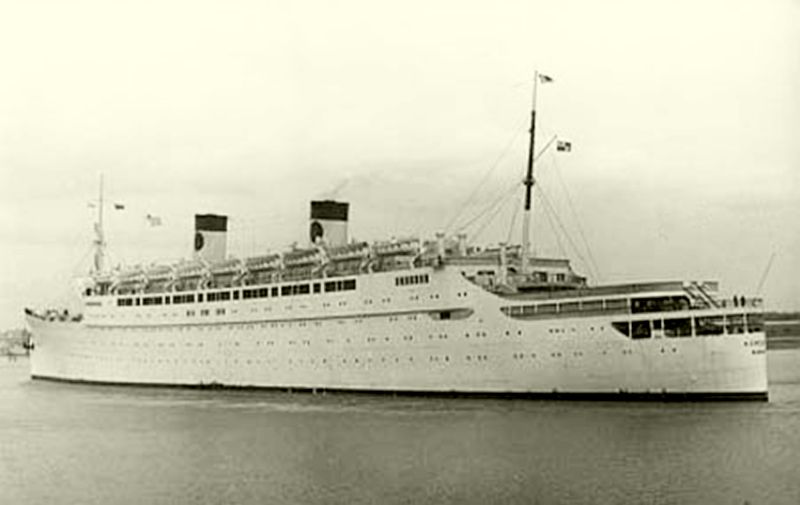
A
fine view of the ships stern, a good way to remember the first of the Matson
Lines trio built
known
as the “White Fleet” as well as later becoming the superb Home
Lines SS Homeric
Photographer
unknown – Please see photo notes at the bottom of the page!
“Blue Water
Liners sailing to the distant shores.
I watched them come, I watched them go and I watched them die.”
****************************
Visit
our ssMaritime Main INDEX
Where
you will discover well over 700 Classic Passenger & Passenger-Cargo Liners!
ssMaritime.com & ssMaritime.net
Where
the ships of the past make history
&
the 1914 built MV Doulos Story
Please
Note: ssmaritime and associated sites are 100%
non-commercial and the author seeks no funding or favours of any shape or form,
never have and never will!
Photographs
on ssmaritime and associate pages are by the author or from the author’s
private collection. In addition there are some images that have been provided
by Shipping Companies and private photographers or collectors. Credit is given
to all contributors. However, there are some photographs provided to me without
details regarding the photographer/owner concerned. I hereby invite if owners
of these images would be so kind to make them-selves known to me (my email
address may be found on www.ssmaritime.com only), in order that due credit may be
given.
ssMaritime
is owned & ? Copyright by Reuben Goossens - All Rights Reserved
Corum replica Patek Philippe Replica Watches IWC Portuguese Replica Rolex Cellini Replica




























